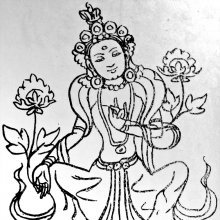Vashyatara, Vaśyatārā, Vashya-tara: 1 definition
Introduction:
Vashyatara means something in Buddhism, Pali. If you want to know the exact meaning, history, etymology or English translation of this term then check out the descriptions on this page. Add your comment or reference to a book if you want to contribute to this summary article.
The Sanskrit term Vaśyatārā can be transliterated into English as Vasyatara or Vashyatara, using the IAST transliteration scheme (?).
Images (photo gallery)
In Buddhism
Tibetan Buddhism (Vajrayana or tantric Buddhism)
Source: archive.org: The Indian Buddhist IconographyVaśyatārā (वश्यतारा) refers to one of the various emanations of Amoghasiddhi, as mentioned in the 5th-century Sādhanamālā (a collection of sādhana texts that contain detailed instructions for rituals).—Her Colour is green; her Symbol is the lotus; her Āsana is bhadrāsana; her Mudrā is the varada.—Vaśyatārā, is also known by the name of Āryatārā, and only one Sādhana in the Sādhanamālā is assigned to her.
Vaśyatārā and Khadiravaṇī-Tārā.—There is practically no difference between her form and that of Khadiravaṇī-Tārā in as much as both display the varada-mudrā in the right hand and carry the utpala in the left. Both have green colour, and both bear the image of Amoghasiddhi on their crowns. In the case of Khadiravaṇī-Tārā, however, no mention is made regarding the attitude in which she should stand or sit, but here it is expressly mentioned that Vaśyatārā should be seated in the bhadrāsana, which resembles the European fashion of sitting with both legs dangling below. This āsana, or the attitude of sitting alone distinguishes Vaśyatārā from other ordinary Tārās carrying the utpala in the left and exhibiting the varada-mudrā in the right. The other point of difference between Khadiravaṇī-Tārā and Vaśyatārā is, that the former is accompanied by the two goddesses, Aśokakāntā Mārīcī and Ekajaṭā, whereas the latter is without companions. Khadiravaṇī may sit or stand in any attitude, but the Sādhana prescribes the Bhadrāsana only for Vaśyatārā.

Tibetan Buddhism includes schools such as Nyingma, Kadampa, Kagyu and Gelug. Their primary canon of literature is divided in two broad categories: The Kangyur, which consists of Buddha’s words, and the Tengyur, which includes commentaries from various sources. Esotericism and tantra techniques (vajrayāna) are collected indepently.
See also (Relevant definitions)
Partial matches: Vashya, Tara.
Full-text: Aryatara.
Relevant text
Search found 1 books and stories containing Vashyatara, Vaśyatārā, Vashya-tara, Vaśya-tārā, Vasyatara, Vasya-tara; (plurals include: Vashyataras, Vaśyatārās, taras, tārās, Vasyataras). You can also click to the full overview containing English textual excerpts. Below are direct links for the most relevant articles:
The Indian Buddhist Iconography (by Benoytosh Bhattachacharyya)
